Simple Yet Powerful Diet Chart for Old Age (Based on Real Needs)
This diet chart for old age focuses on what matters: steady energy, better digestion, and healthy aging without complication.
Did you know that nearly 60% of older adults face nutrition-related health issues, according to the World Health Organization? That’s huge, but here’s the good news—you can change it.
Eating the right foods isn’t about chasing fancy diets; it’s about simple, smart choices that give you steady energy, stronger bones, and better digestion.
If you’re over 50 (or planning for someone who is), this guide on a diet chart for old age will show you exactly what works, what to avoid, and how small changes can help you stay active and healthy longer.
Why a Diet Chart for Old Age Matters
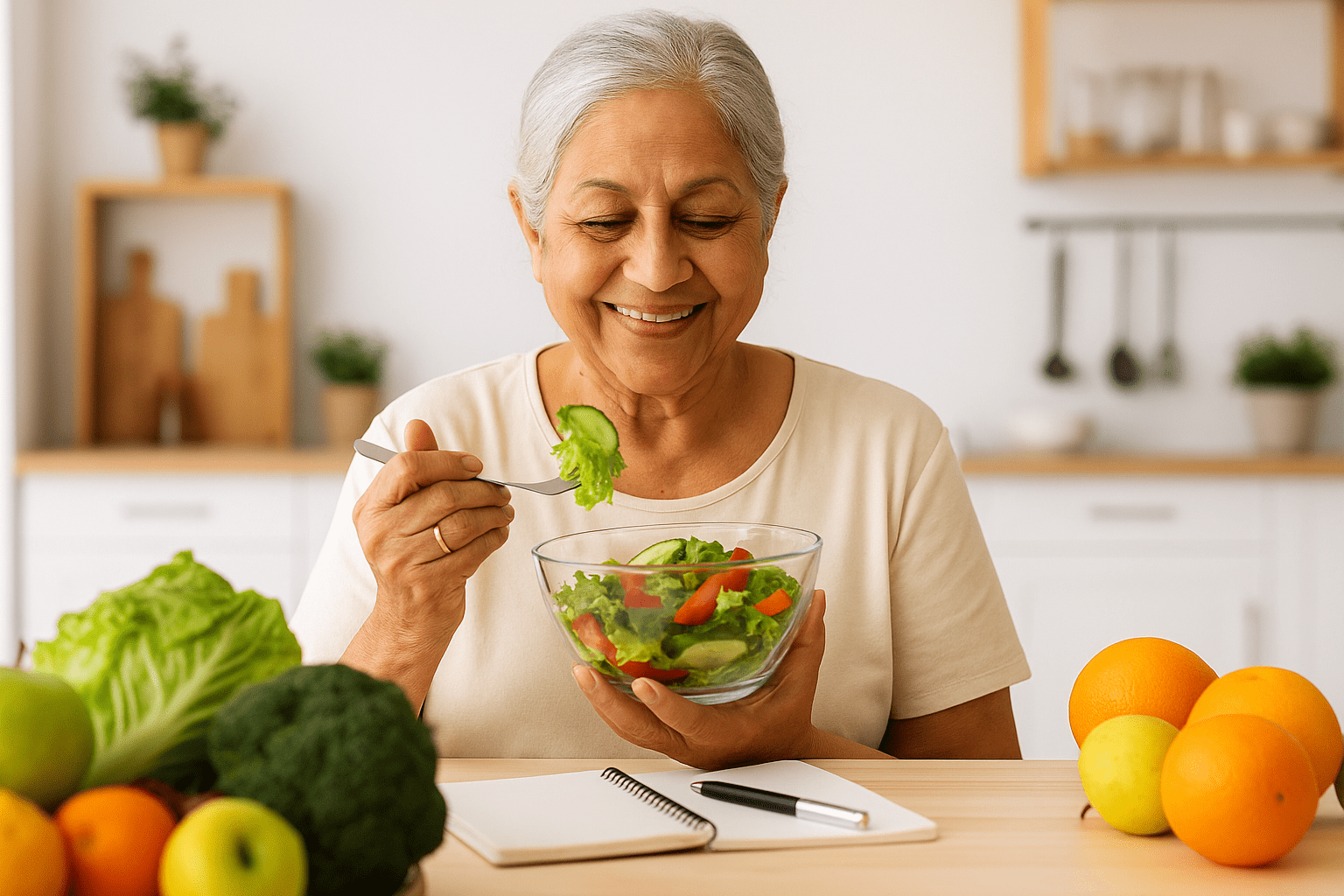
Eating well after 50 is not just about staying full. It’s about keeping your body strong, your mind sharp, and preventing chronic diseases.
A well-planned diet chart for old age gives you all the essential nutrients in the right amounts. This helps maintain steady energy levels, better digestion, and long-term heart health.
The Link Between a Balanced Diet and Healthy Aging
A balanced diet means eating the right mix of food groups—whole grains, proteins, vegetables, and healthy fats. Skipping this balance may cause weakness, poor nutrient absorption, or even problems like high blood pressure.
-
According to the National Institute on Aging, seniors who follow a balanced diet lower their risk of heart disease and blood pressure issues.
-
Adding nutrient rich foods such as vegetable soup, brown rice, and lightly cooked vegetables makes a big difference in overall health.
-
Limiting processed foods, fried foods, and excess saturated fats helps you stay healthy and active.
In simple words: the right food choices at this stage of life can make all the difference between just living and living well.
Discover Personalized Nutrition Plans with Balance Bite. Perfect for seniors who want more than a generic chart. Balance Bite offers easy, customized plans designed to fit your age, health goals, and taste preferences.
Key Components of a Healthy Diet for Seniors
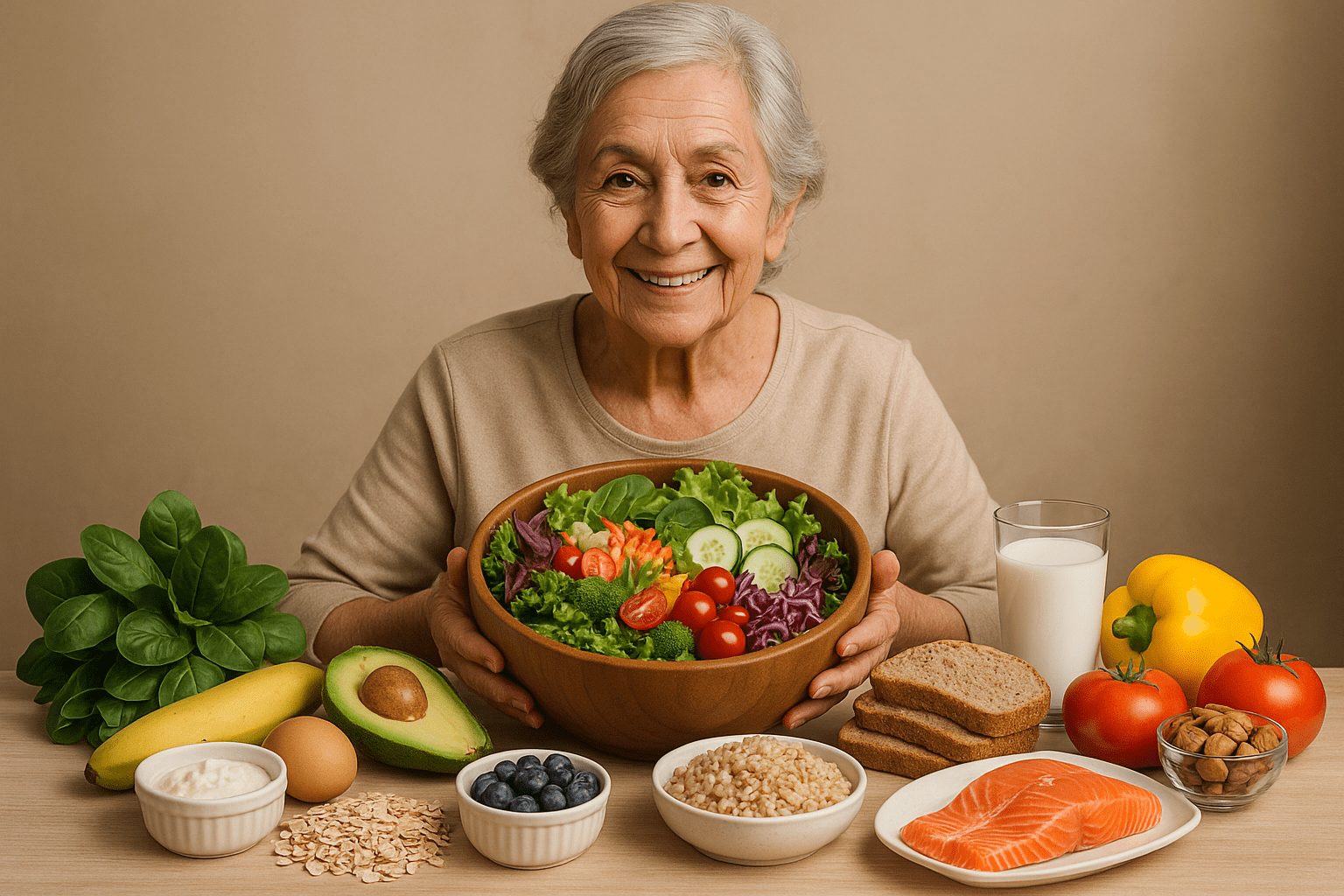
1. Balanced Food Groups
A balanced diet includes all major food groups—fruits, vegetables, whole grains, proteins, and healthy fats.
For example, start your day with vegetable soup, add brown rice or whole wheat pasta for lunch, and keep dinner light with cooked vegetables and grilled fish. This mix supports steady energy levels and good digestion.
-
Include: nutrient dense foods like lentils, chia seeds, and sweet potatoes
-
Limit: fried foods, processed meats, and snacks high in trans fats
2. Essential Nutrients
Your body still needs all the nutrients—calcium for bones, protein for muscles, and vitamins for immunity. B vitamins and vitamin C protect your heart health and brain health.
Seniors who eat enough essential nutrients have lower risks of high blood pressure and heart disease (National Institute on Aging, 2023).
3. Nutrient-Rich Foods Over Processed Foods
Not all calories are equal. Fresh, nutrient rich foods like raw vegetables, sautéed vegetables, and roasted chickpeas help with gut health and improve nutrient absorption.
On the other hand, processed foods packed with salt, sugar, and saturated fats harm overall health. Eating nutrient-rich foods daily offers many health benefits, from stronger immunity to better heart health.
Shop Healthy, Ready-to-Use Ingredients at Balance Bite. Why spend hours planning? Balance Bite makes it easy with curated, nutrient-rich options like whole grains, low-fat snacks, and gut-friendly foods delivered to your door.
4. Protein for Muscle Strength
As you age, your muscles naturally lose strength. A well-planned diet chart for old age should include enough protein to slow this process.
The National Institute on Aging suggests older adults eat protein-rich foods at every meal to protect muscles. Good choices are grilled fish, light chicken curry, lentils, and lean meats.
-
Try: eggs, roasted chickpeas, or nut butters on whole grain toast.
-
Avoid: heavy, fried foods or processed meats that add unhealthy saturated fats.
Protein is not only for athletes. It helps seniors maintain mobility, independence, and better health.
5. Healthy Fats for Brain and Heart
Not all fats are bad. The right fats help with brain health, memory, and heart health. Seniors should replace saturated fats and trans fats with healthy fats like nuts, seeds, olive oil, and coconut oil.
The American Heart Association notes that switching to unsaturated fats lowers cholesterol levels and reduces the risk of heart disease.
-
Add: avocados, chia seeds, and small portions of nut butters.
-
Limit: oily food, bakery items, and packaged snacks high in trans fats.
6. Gut-Friendly Choices
Digestion slows with age, so gut health becomes key. A strong gut helps with nutrient absorption and prevents bloating or discomfort. Seniors should eat cooked vegetables, soups, and vegetable soup for easy digestion.
Raw vegetables and sautéed vegetables also add fiber, which lowers blood pressure and supports overall health.
-
Choose: sweet potatoes, whole grains, and light dals.
-
Reduce: processed foods and excess sugar, which upset the gut.
7. Hydration and Energy
Water is just as important as food in a diet chart for old age. Seniors often feel less thirsty, but the body still needs fluids to stay active. Dehydration can cause tiredness, dizziness, or even affect blood pressure. According to the CDC, older adults are at higher risk of dehydration than younger people.
-
Drink: water, herbal teas, and light vegetable soup.
-
Limit: sugary drinks and sodas that raise blood sugar without adding essential nutrients.
Hydration also helps with digestion, keeps joints healthy, and improves energy levels through the day.
8. Portion Control Matters
Eating the right amount is key to better health. Large meals can make seniors feel heavy and affect gut health. On the other hand, skipping meals can lower energy levels and harm overall health.
-
Use small plates to manage portion control.
-
Break meals into 4–5 smaller servings.
-
Avoid overeating fried foods or oily food at one sitting.
This method helps regulate blood sugar, supports nutrient absorption, and prevents weight gain that can lead to chronic diseases.
9. Variety for Taste and Enjoyment
With age, taste buds may weaken. That’s why variety is important in a diet chart for old age. Adding different foods keeps meals enjoyable and ensures you get all the nutrients.
-
Try: brown rice, sweet potatoes, grilled fish, or light chicken curry.
-
Add snacks like roasted chickpeas, coconut chutney, or nut butters for flavor.
-
Use cooking methods like steaming or sautéed vegetables with olive oil.
What Makes a Balanced Diet Important After 50
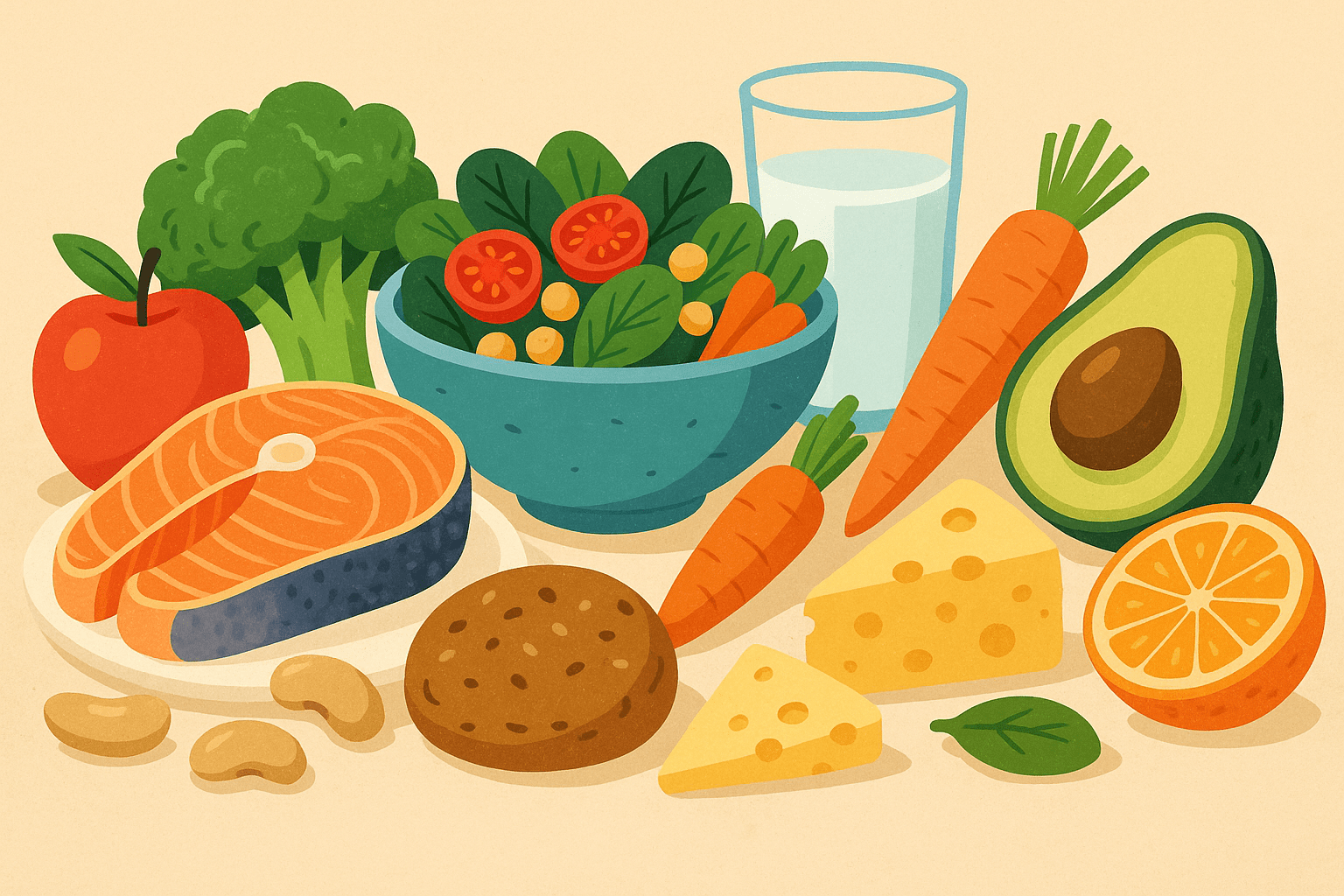
After 50, your body changes. Metabolism slows, bones weaken, and digestion gets harder. A diet chart for old age helps you meet daily nutritional needs without extra calories.
Adding whole grains, nutrient rich foods, and healthy fats supports heart health and prevents chronic diseases. As the NIH notes, “Balanced meals lower risks of high blood pressure and heart disease.”
Understanding Nutritional Needs in Old Age
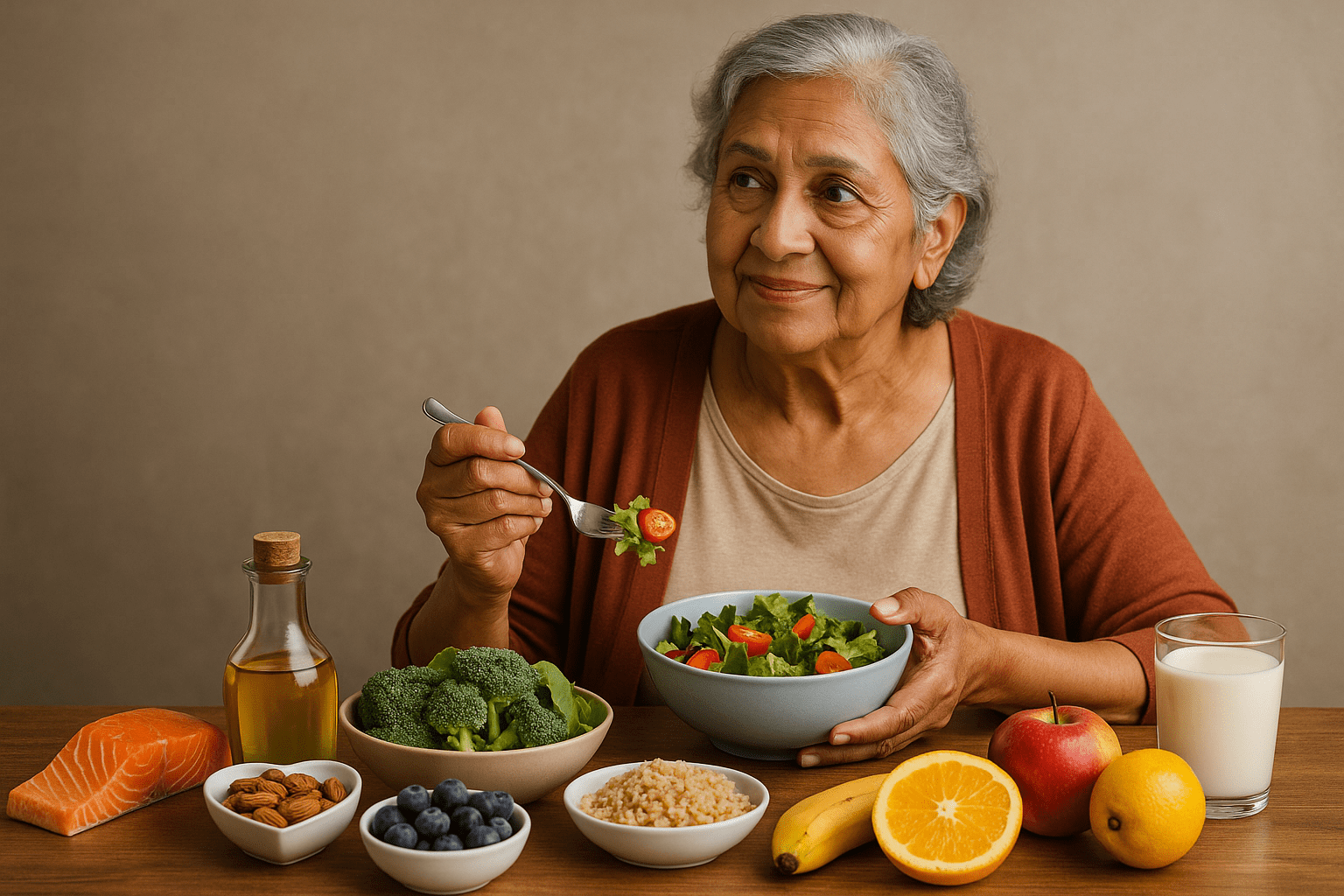
As we age, our nutritional needs change. A diet chart for old age must focus on essential nutrients like calcium, protein, and vitamins that support bones, muscles, and immunity.
The World Health Organization reports that nearly 1 in 3 seniors suffer from nutrient deficiencies due to poor diet or weak digestion. Meeting these needs is key to better health and preventing chronic diseases.
How Gut Health and Nutrient Absorption Change with Age
Digestion slows with age. This affects gut health and how well your body absorbs all the nutrients from food. Seniors may face issues like low stomach acid, which reduces nutrient absorption of vitamins like B12 and minerals like calcium. Poor gut function can also affect blood pressure and overall energy.
-
Choose easy-to-digest meals like vegetable soup, light dals, and cooked vegetables.
-
Add fiber-rich whole grains and sweet potatoes to improve digestion.
-
Include probiotics (yogurt or buttermilk) for healthy gut bacteria.
-
Avoid heavy fried foods, excess oily food, and processed foods that upset the stomach.
Sample Balanced Diet Plan for Old Age
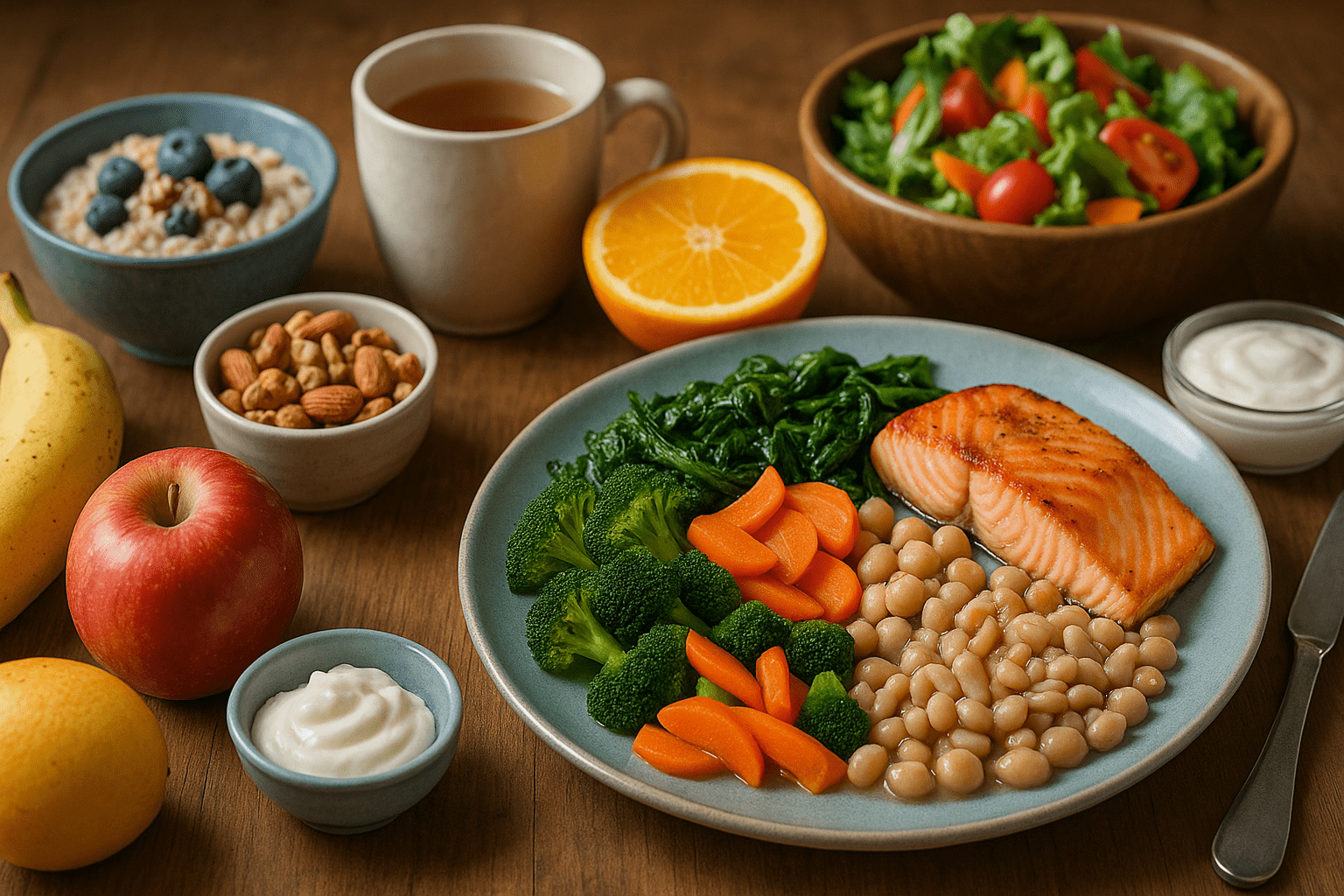
Creating a diet chart for old age is about balance, variety, and easy-to-digest meals that meet daily nutritional needs. Seniors need all the nutrients—proteins, vitamins, minerals, and healthy fats—in the right portions to maintain energy levels, protect heart health, and support gut health.
Here’s an example of a sample balanced diet chart for seniors above 60:
Morning (7:00 – 8:00 AM)
-
Warm water with lemon (aids digestion and nutrient absorption)
-
Handful of soaked almonds or chia seeds (rich in essential nutrients)
Breakfast (8:30 – 9:30 AM)
-
1 bowl of vegetable soup or lightly cooked vegetables
-
1 portion of brown rice or whole wheat pasta (great source of complex carbohydrates)
-
Option: light chicken curry or grilled fish for protein (can be replaced with lentils for a vegetarian diet)
Mid-Morning Snack (11:00 AM)
-
1 fruit (papaya, apple, or orange rich in vitamin C)
-
A small bowl of roasted chickpeas or nut butters on whole-grain toast
Lunch (1:00 – 2:00 PM)
-
1 cup cooked rice or 2 whole grains rotis
-
Light dal with cooked vegetables
-
Side salad with raw vegetables for fiber and gut health
-
Small portion of chicken curry or lean meats (optional)
Evening Snack (4:00 – 5:00 PM)
-
1 bowl of vegetable soup or light sautéed vegetables
-
Herbal tea with a teaspoon of coconut chutney or a handful of nuts
Dinner (7:00 – 8:00 PM)
-
2 chapatis (made from whole grains) or a small serving of sweet potatoes
-
Grilled fish or light lentil curry for protein
-
Steamed/cooked veggies drizzled with olive oil or coconut oil
Before Bed (9:00 – 9:30 PM)
-
A glass of warm turmeric milk (helps with sleep, bone strength, and relaxation)
Healthy Chicken Curry Recipe for Old Age
A light chicken curry can be a tasty and healthy protein option for seniors. Unlike heavy, oily curries, this version uses minimal spices and focuses on easy digestion while still providing flavor and essential nutrients.
Ingredients (Serves 2):
-
150 g skinless chicken (boneless pieces, easy to chew)
-
1 tbsp olive oil or coconut oil
-
1 small onion, finely chopped
-
1 tomato, pureed
-
1 tsp ginger-garlic paste
-
½ tsp turmeric and cumin (mild spice, easy on digestion)
-
1 cup lightly cooked vegetables (carrot, beans, peas)
-
Salt (very little) and fresh coriander for garnish
Cooking Method:
-
Heat oil in a pan and sauté onion until soft.
-
Add ginger-garlic paste and tomato puree; cook until light.
-
Mix in turmeric and cumin, then add chicken pieces.
-
Cook on low flame until chicken turns tender.
-
Add vegetables and half a cup of water; simmer for 10 minutes.
-
Garnish with coriander and serve warm.
Why It Works for Seniors:
-
High-quality protein supports muscle strength and recovery.
-
Mild spices aid digestion and avoid irritation common with heavy curries.
-
Added vegetables provide essential nutrients and improve gut health.
-
Low oil and reduced salt protect heart health and manage blood pressure.
Foods to Avoid for Optimal Health
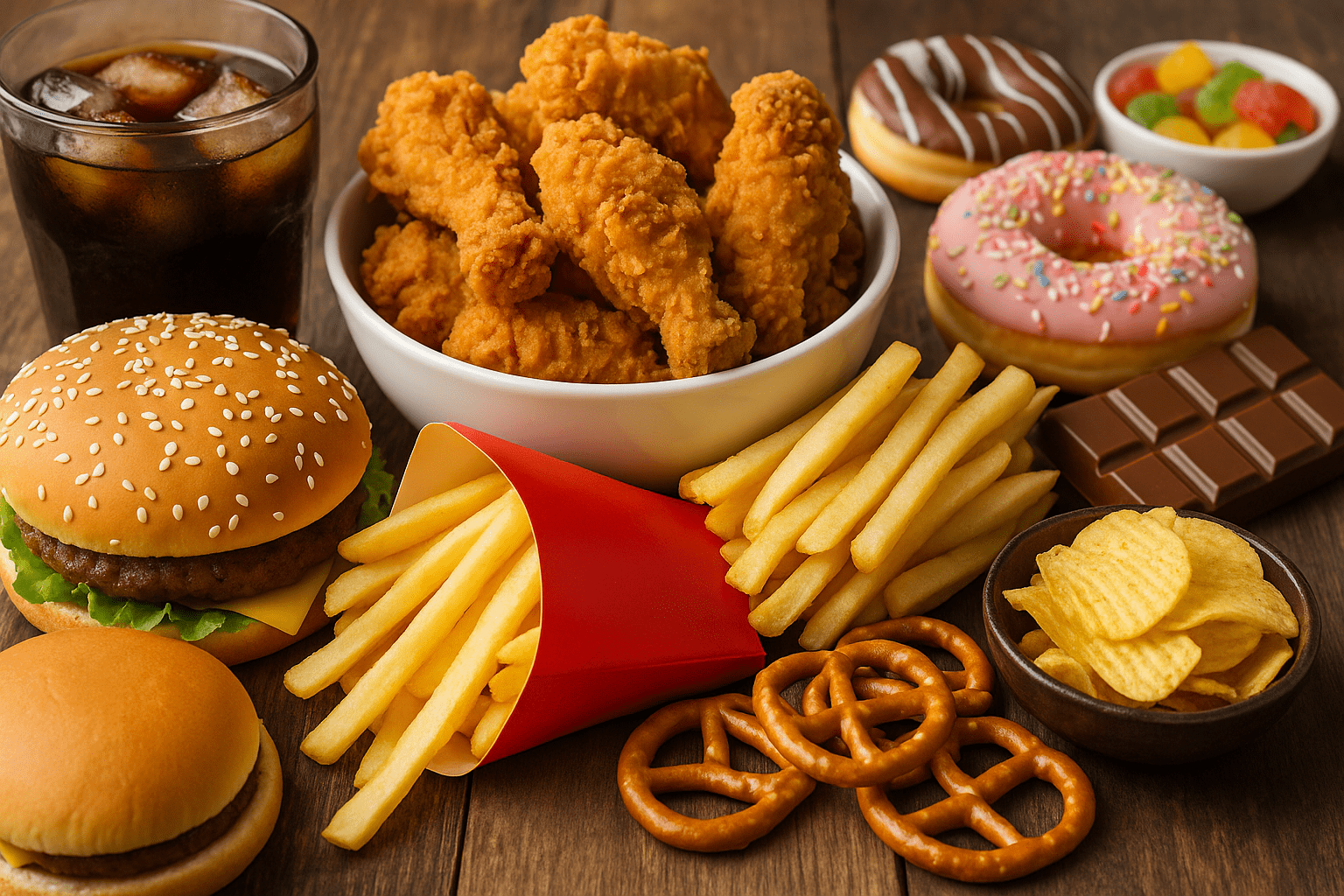
A diet chart for old age is not only about what to eat, but also about what to limit. Certain foods may taste good, but they can harm your body as you age. Let’s look at foods seniors should avoid for better health.
-
Processed Foods: Packaged snacks, canned meals, and ready-to-eat items are high in salt, sugar, and preservatives. These reduce nutrient absorption and raise blood pressure. Fresh, nutrient rich foods are always the better choice.
-
Fried and Oily Foods: Deep-fried foods and heavy oily food slow down digestion and raise cholesterol. They also lower energy levels and increase the risk of heart disease.
-
Saturated Fats & Processed Meats: Butter, cream, and processed meats like sausages add harmful saturated fats. These increase cholesterol levels and put stress on the heart. Replace them with grilled fish, lean meats, or plant proteins.
-
Sugary Beverages and Sweets: Sodas, cakes, and candy may give quick energy, but they spike blood sugar. Over time, they damage overall health and increase the risk of diabetes. Try fruits or sweet potatoes instead.
-
Too Much Salt: Salt in excess raises blood pressure and increases the risk of stroke. The American Heart Association advises limiting sodium to less than 1,500 mg daily after age 50.
-
Refined Carbs: White bread, polished rice, and sweets are low in fiber and high in calories. Replace white rice with brown rice or whole grains for steady energy and improved nutrient absorption. They do not provide essential nutrients and can lead to weight gain. Choose whole grains like brown rice or whole wheat pasta instead.
-
Fried Snacks & Trans Fats: Biscuits, chips, and packaged fried snacks contain harmful trans fats. These clog arteries, harm heart health, and lower energy levels. Always check food labels for “partially hydrogenated oils.”
-
Overeating Red Meat: While protein is important, too much red meat increases risks of chronic diseases and digestion problems. Replace it with lighter meals like vegetable soup or cooked vegetables paired with lentils.
How the Right Food Choices Protect Against High Blood Pressure and Heart Disease
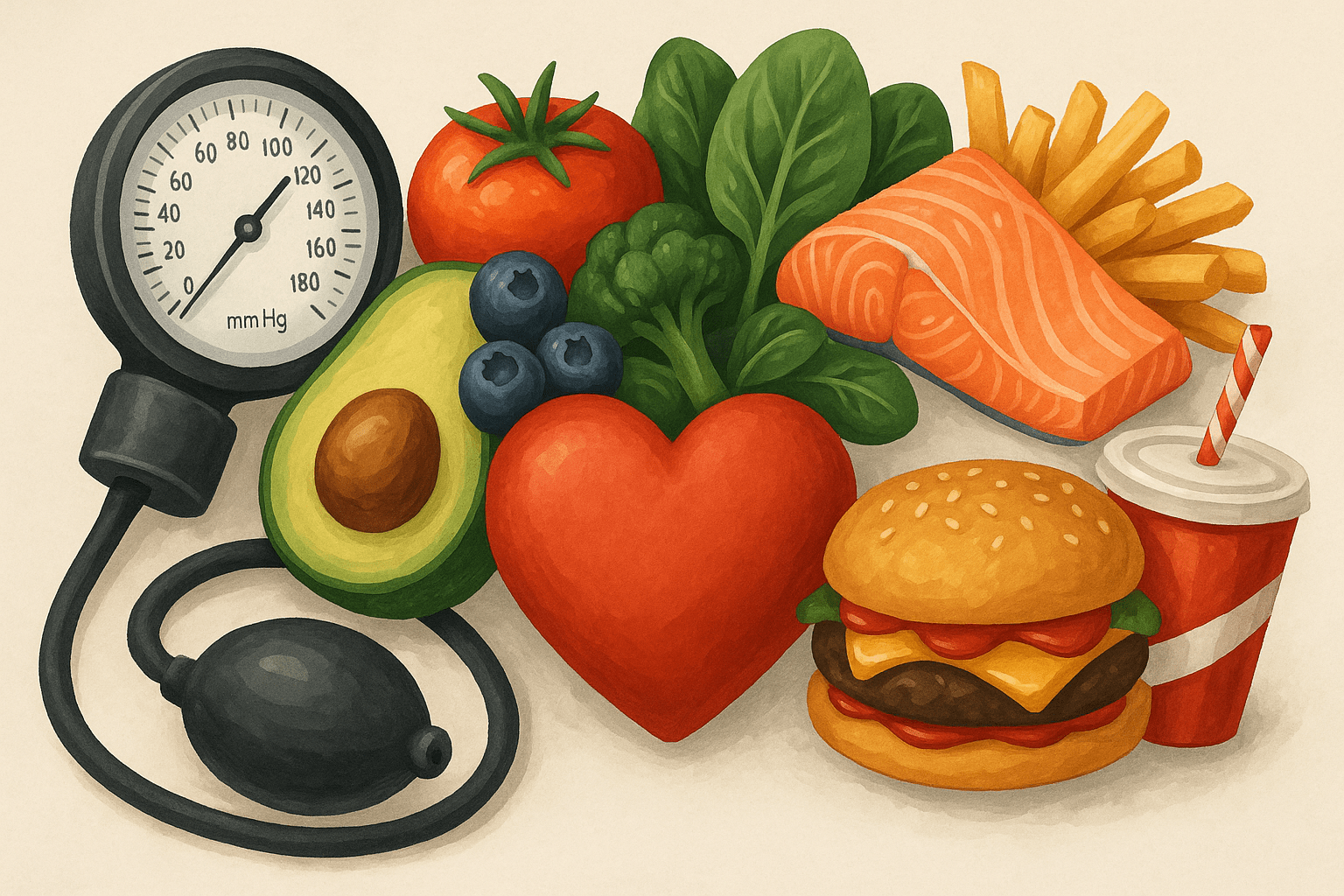
Eating smart can protect your heart and keep blood pressure under control. A balanced diet chart for old age helps you avoid risks linked with poor diet.
The World Health Organization notes that nearly 1.3 billion people worldwide suffer from high blood pressure, many of them over 50. The good news? The right food choices make a big difference.
Why Food Choices Matter:
-
Whole grains like brown rice and whole wheat pasta keep blood sugar steady and lower heart strain.
-
Healthy fats from olive oil, nuts, and seeds replace harmful saturated fats and trans fats that clog arteries.
-
Lean meats and grilled fish give protein without the risks of too much red meat or processed meats.
-
Fresh cooked vegetables, vegetable soup, and sweet potatoes provide fiber that supports gut health and reduces cholesterol levels.
Practical Tips for Planning Meals in Old Age
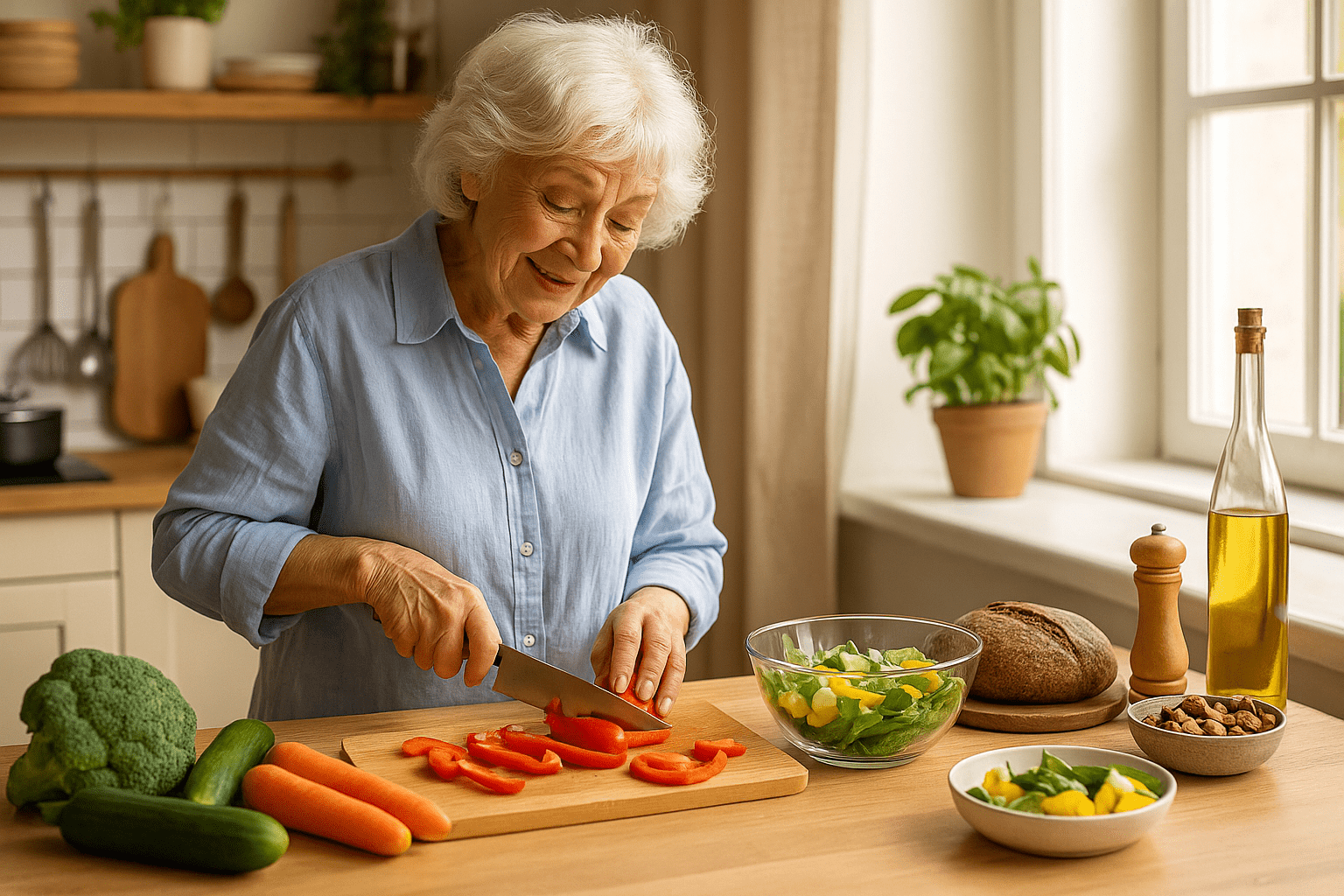
-
Stick to a Routine: Eating at the same times daily keeps digestion regular and helps manage blood sugar and blood pressure. Seniors who follow a routine are less likely to overeat or miss meals.
-
Plan Balanced Meals Ahead: Each meal should cover all food groups—whole grains, proteins like lean meats or lentils, and cooked vegetables. Planning ensures you don’t depend on processed foods or unhealthy last-minute choices.
-
Mix Different Foods for Variety: As taste buds change with age, variety keeps meals exciting. Add brown rice, sweet potatoes, or light chicken curry to ensure balanced meals. Variety also makes it easier to meet daily nutritional needs.
-
Choose the Right Cooking Methods: Switch from frying to steaming, grilling, or sautéing with olive oil or coconut oil. Choose low fat cooking methods like steaming or grilling to keep meals light and easier to digest. These methods lower saturated fats and trans fats while keeping meals flavorful.
-
Prepare Easy-to-Digest Recipes: Pick meals that support digestion, like vegetable soup, light dals, or sautéed vegetables. These help with nutrient absorption and reduce stomach discomfort.
-
Batch Cooking & Freezing: Cooking in batches saves time and ensures a ready supply of healthy meals. For example, prepare cooked rice or soups in advance and freeze in small portions.
-
Include Healthy Snacks: Instead of chips or sweets, keep handy snacks like roasted chickpeas, nut butters on whole grain toast, or fresh fruit rich in vitamin C. These options help maintain steady energy levels.
Lifestyle Habits that Support a Healthy Body

1. Combine Diet with Physical Activity
Healthy eating works best when paired with daily movement. Light physical activity like walking, yoga, or stretching keeps joints flexible and improves heart health.
Even 20 minutes a day helps lower blood pressure and boosts energy levels. Pairing a balanced meal with a short walk is one of the easiest ways to stay active.
2. Prioritize Sleep and Rest
Good sleep is as important as good food. Seniors need 7–8 hours of rest each night. Lack of sleep affects blood sugar, weakens immunity, and reduces focus.
A warm cup of milk or light vegetable soup at night can improve sleep quality. According to the National Institute on Aging, proper rest also improves how your body uses essential nutrients.
3. Avoid Harmful Foods and Habits
Limiting harmful foods protects long-term health. Cut down on processed foods, fried foods, saturated fats, and trans fats. These raise cholesterol levels and increase the risk of heart disease.
Replace them with nutrient rich foods like whole grains, sweet potatoes, and cooked vegetables that support gut health and better health overall.
4. Stay Socially Active
Eating well is easier when you share meals. Seniors who eat with friends or family enjoy food more and tend to stick to their balanced diet.
Social activity also reduces stress and supports brain health. Even small steps like joining a community group or having dinner with family can help you stay healthy.
Final Note
A diet chart for old age is more than a list of meals. It is a simple way to enjoy a balanced diet every day and meet your body’s real needs. Add healthy diet habits like more foods rich in fiber, vitamins, and minerals, while keeping your healthy plate free from excess salt or sugar.
Plan your diet plan with small changes you can follow. Think long-term—set realistic health goals. Remember, making healthy options part of daily life not only supports personal wellness but also strengthens overall public health.
Start Your Healthy Aging Journey with Balance Bite Today. Whether your goal is managing blood sugar, improving digestion, or boosting energy, Balance Bite gives you the right tools and foods to make healthy aging simple.




















Leave a comment
Translation missing: en.blogs.comments.discription